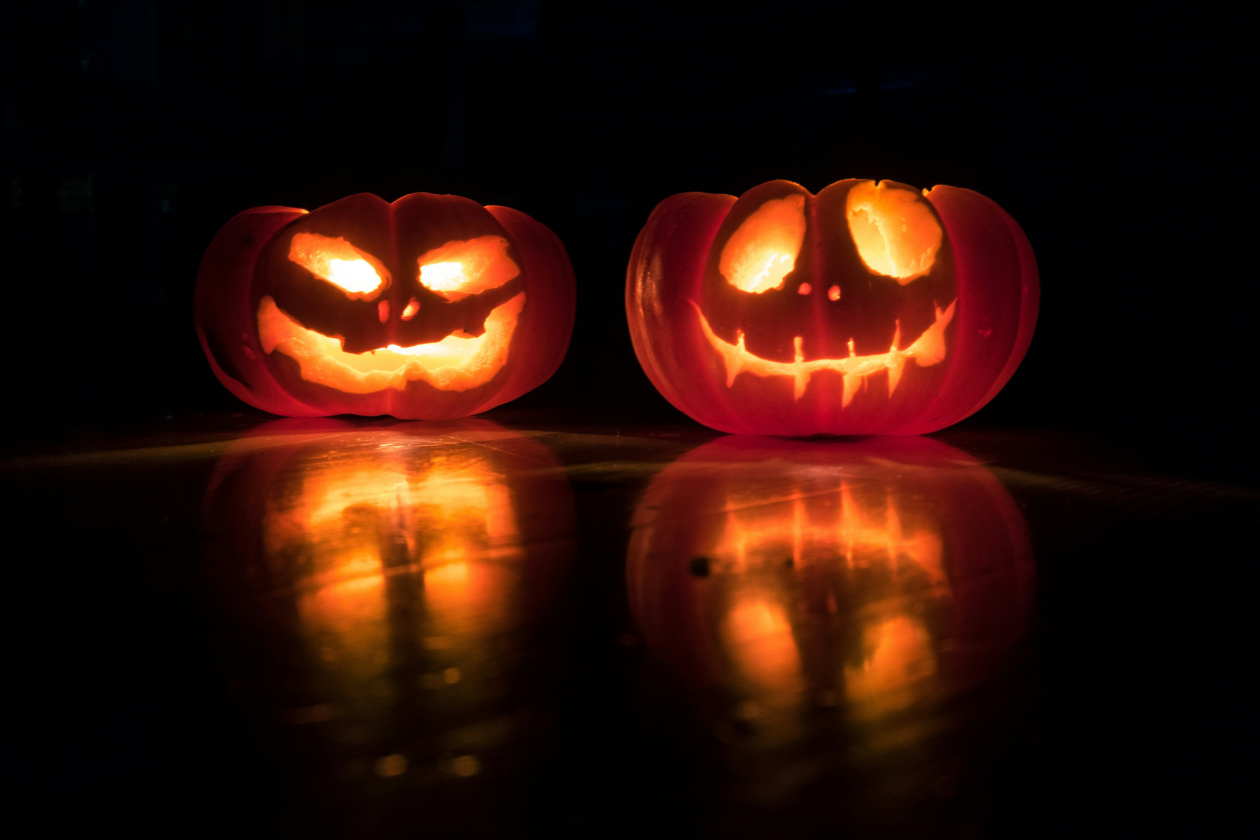 Photo by David Menidrey on Unsplash
Photo by David Menidrey on Unsplash
Úžasné trasy a strašidelné tradície v Európe
Posledná aktualizácia streda, 22/10/2025
Máš chuť zažiť niektoré z najstrašidelnejších európskych tradícií?
Pre dieťa 90. rokov mohlo byť sledovanie filmu „Predvianočná nočná mora“ od Tima Burtona traumatickým zážitkom. Je pravda, že v súčasnosti v nás filmy ako „Coco“, ktorý oslavuje mexický sviatok Dia de los Muertos (Deň mŕtvych), vyvolávajú skôr pocity vrelosti a dojatia (rozprávame sa s vami, dospelými).
Ak však hľadáš naozaj záhadné a trochu strašidelné príbehy, stačí sa len opýtať. Vždy sa v celej Európe nájde priestor, kde tak trochu prechádza mráz po chrbte, najmä v tomto období roka.
Tak si sprav pohodlie, daj si šálku čaju (alebo kúsok tekvicového koláča) a naplánuj si svoju nasledujúcu krátku európsku dovolenku!
Začiatok (pravdepodobne)
Vieš, že vo veľkom oslavovaný Halloween, ktorý je zdrobneninou anglického „All Hallows‘ Eve“ (predvečer Sviatku všetkých svätých), má svoje korene v keltskom rituáli Samhain, čo znamená „koniec leta“? V tých časoch sa Nový rok začínal 1. novembra. V predvečer toho dňa obyvateľstvo, ktoré pozostávalo najmä z poľnohospodárov, vyjadrilo svoju vďaku za letnú úrodu a pripravilo sa na nadchádzajúce zimné mesiace.
Verili, že v tú noc je závoj, ktorý oddeľuje dva svety: živých a mŕtvych, tenší, a preto je pre duchov jednoduchšie zastaviť sa na krátku návštevu.
Počuli ste už legendu o hriešnikovi Jackovi? Írskom opilcovi, ktorého po tom, čo niekoľkokrát oklamal smrť, zradila vlastná pečeň a telo, a to sa postaralo o jeho skon. O zvyšok sa postarala karma a úbohému Jackovi bol pred bránami pekla odopretý vstup. Jack bol odsúdený túlať sa medzi dvoma svetmi so žeravým uhlíkom vloženým do vyrezanej repy.
Toto je pravdepodobne začiatok tradície vyrezávania tekvíc, do ktorých sa vkladajú sviečky, aby si deti, ktoré idú od dverí k dverám v kostýmoch napodobňujú duchov, mohli svietiť na cestu.
Dostaň sa do nálady: Kde?
Keď sa budeme držať témy (a geografickej oblasti), existuje snáď lepšie miesto na trávenie novembrových prázdnin než staré dobré Spojené kráľovstvo? Môže to byť tvoja šanca navštíviť Nessie, legendárnu Lochnesskú príšeru, tvora zo Škótskej vysočiny, ktorý sa preslávil v 30. rokoch 20. storočia.
Keď už budeš na ostrove, môžeš sa dostať do strašidelnej nálady návštevou jedného či oboch žalárov v Londýne alebo Edinburgu. Ak podzemie nie je tvojou šálkou kávy, počkaj si na 5. november („Pamätaj, pamätaj...“), a ak sa ti páči film „V ako vendeta“, nesmieš si nechať ujsť Noc Guya Fawkesa. Vatry a ohňostroje osvetľujú mesto na pamiatku Sprisahania pušného prachu z roku 1605, kedy sa Fawkes, katolícky konšpirátor, neúspešne pokúsil vyhodiť do vzduchu parlament a zabiť protestantského kráľa Jakuba I.
Prejdi cez prieliv na kontinent, kde môžeš navštíviť Múzeum mučenia v Amsterdame. Ponoríš sa do histórie Európy a uvidíš okrem iného aj 40 nástrojov pochádzajúcich z rôznych krajín, ktoré kedysi slúžili na trestanie a mučenie.
Keď je reč o nástrojoch, vedeli ste, že na Deň všetkých svätých zvykli niektorí Nemci skrývať nože v domoch? Prečo? Aby im neublížili duchovia, väčšinou zosnulí členovia rodiny, ktorí sa v ten deň mohli potulovať po dome. A to ste si mysleli, že prízraky sú bez tela!
Očividne môžu byť aj hladné a/alebo smädné, a preto, rovnako ako deti nechávajú sladkosti pre Santa Clausa, Rakúšania prízrakom nechávajú chlieb a vodu, keby mali náladu robiť neplechu.
Možno si predsa len radšej duše prestavuješ hmotnejšie, možno ako hŕbu pohybujúcich sa kostí v tvare kostlivca. Tri rôzne miesta v troch európskych krajinách utíšia tvoju zvedavosť, vydajme sa z východu na západ.
Neďaleko Prahy, veľkolepého hlavného mesta Českej republiky, leží mesto Kutná Hora s niečo vyše 20 000 obyvateľmi a v ňom sa nachádza Sedlecká kostnica, rímsko-katolícka kaplnka, ktorá vznikla v roku 1278 a nachádza sa pod cintorínskym kostolom Všetkých svätých. Vieš, že existuje luster z kostí? A nie len tak nejakých! Kým sa naň pozeráš, vyskúšaj si nájsť každú z 200 rôznych druhov kostí, ktoré sa nachádzajú v ľudskom tele. Samotná kostnica obsahuje 40 000 až 70 000 kostier, čo je trikrát viac, než je súčasný počet obyvateľov najbližšieho mesta.
Krátka cesta lietadlom alebo dlhá cesta vlakom do Talianska a môžeš zažiť niečo podobné, no tentokrát v centre hospodárskeho hlavného mesta krajiny, v Miláne. Krátka zastávka v metre San Babila a hneď za veľkolepou Milánskou katedrálou nájdeš malú a veľmi nezvyklú svätyňu: San Bernardino alle Ossa. Kosti a lebky namiesto tapety, po celom strope, kosti a lebky všade. Zdá sa, že na začiatku minulého tisícročia nebolo dosť miesta na kosti, ktoré prichádzali z neďalekej nemocnice, a preto museli byť trochu kreatívnejší.
Ďalej na západ, v portugalskom meste Evora, nájdeš kostnicu inšpirovanú tou z Talianska. Kaplnka kostí pochádza zo 16. storočia a návštevníkov víta pomerne lákavým nápisom: “Nós ossos que aqui estamos, pelos vossos esperamos,” v preklade: „My, kosti, sme tu, čakáme na tie vaše.“ Už cítiš zimomriavky?
Čerešnička na torte a pomaly klasika: hrad Bran (známy ako Drakulov hrad) v Transylvánii. Nevynechaj jedno z miest spájaných s legendárnym upírom a zakonči svoju cestu mrazivým piknikom v rumunskom lese Hoia Baciu, ktorého ohnuté stromy v tebe vyvolajú nostalgiu ako zo Zakázaného lesa v Rokforte.
Keď tam už budeš, polož na typický červeno-biely kockovaný obrus pár jabĺk v karameli, porciu akejkoľvek tekvice a nejaké „fave dei morti“, Talianmi v preklade nazývané „fazuľa mŕtvych“.
Tak tu máš príbehy, jedlo a miesta, ktoré môžeš navštíviť. Vyber si kostým a nechaj sa očariť týmito starými európskymi tradíciami a neboj sa, stará dobrá plachta s dvomi dierami na oči sa stále nosí.